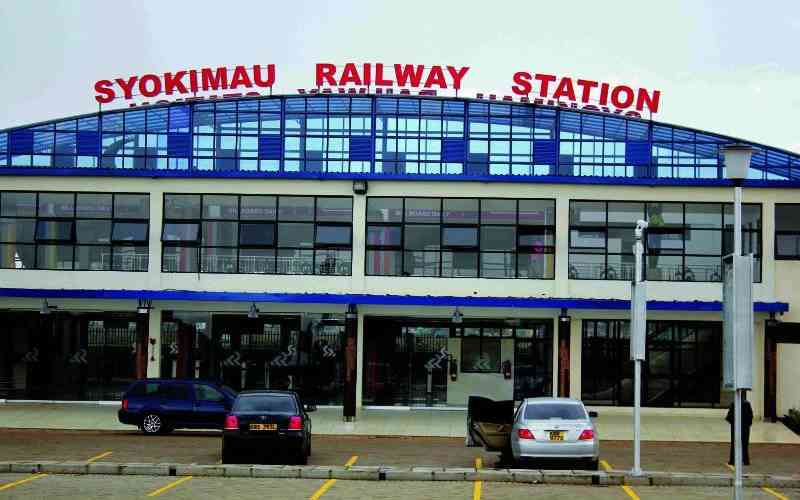Today, any mention of ‘Syokimau’ brings back memories of gigantic caterpillars pulling down multi-million shilling investments and tearing apart people’s dreams and hopes of ever owning a home.
Syokimau, the venue of the most deliberate demolitions of multi-million shilling homes, has become a curse word and password for poverty for hundreds of victims.
Syokimau, which is located next to Jomo Kenyatta International Airport, has been abandoned like a desecrated Ithembo (shrine) whose trees have been felled.
It is as silent as a disused graveyard, signifying the death of people’s dreams that have left them wallowing in despair and nasty memories.
Kamba medicine woman
Long before Kenya as a country came into existence and any of her land had been surveyed and registered as titled property, the bearer of the name ruled supreme.
Although facts, fiction and myths have intermixed to create a legend, there is universal agreement that the name refers to an ancient Kamba medicine woman who lived in the 1800s.
There are conflicting narratives explaining who Syokimau really was, and at times her name is mentioned in the same breath with that of Masaku, the legendary seer after who Machakos town is named.
Maurice Barasa, a researcher and a PhD History student at Kenyatta University, says Syokimau was a powerful medicine woman, a witch and a prophet.
Barasa’s research has taken him to Iveti Hills, 8.4km from Machakos town where he traced some of the prophet’s descendants.
Iveti Hills, derived from the word Iveti, meaning women in Kamba was appropriately named so during the fierce intercommunity battles between the Akamba and the Maasai.
During those days, the area around Machakos was the battlefield between the pastoral Maasai whose weapon of choice was the spear while the Akamba were the master archers whose arrows never missed.
Conventional rules of engagement dictated that women and children be evacuated from the battlefield because they were treated as booties of war.
Whenever the communities fought in what is at present known as Machakos, the women and children would be kept out of harm’s way at the hills, where any enemy approaching could be spied on from afar.
Predict attacks
Stay informed. Subscribe to our newsletter
Back to the legend of Syokimau, some historians believe she was born in Kitunduni Village in Iveti Hills.
Barasa writes in his paper, On the Trails of Syokimau, the Akamba Legendary Prophetess, that one of the narratives trace the woman’s origin to the hills.
He writes, “Mzee Thomas Mbithi Muli, 76, a relative of Syokimau says she was born and raised in Kitunduni Village on Iveti Hills of Machakos County long before the coming of the white men in Kenya. He estimates she was born in the 1820s.”
He further writes that it was on these hills that she lived, overlooking Kiima Kimwe, where her contemporary and rival also plied his medicine and mystical powers.
It was at Iveti that Syokimau made a name for herself: she endeared herself to the warriors as she could predict an attack by the Maasai long before they came, giving the Akamba ample time to prepare for defence.
Besides predicting the attacks, Syokimau would also pray and offer sacrifices on behalf of the Akamba warriors whenever they were about to go to war with their neighbours.
At times, Barasa writes, the Akamba would take war to the enemies and stage attacks to as far as Magadi. Such raids were used as a way of acquiring cattle that at the time were a form of currency and symbol of wealth.
It was as a result of the cattle raids success that Syokimau’s name and fame traveled far and wide, as her contemporaries treated her with respect. In Athi River, a local prophetess, Syonguu, was so impressed by Syokimau that she named a village in her territory after her.
To date, Syokimau in Athi River where the colonialists had constructed a railway station still bears the prophetess’s name.
Consulted for solutions
Barasa explains; “When plague broke out, the Akamba consulted Syokimau for solutions. The area known as Syokimau near Athi River,” says Mzee Ndeti, 96, father of Kathiani MP Wavinya Ndeti, was given the name by Syonguu, an Akamba prophetess in honour of Syokimau.”
Depending on Syokimau’s advice, the Akamba would attack or call off a raid on their enemies. Most of the battles against the Maasai took place on the fringes of what is at present Mavoko Municipality, avers Mzee Ndeti. Athi-River grew as a result of the arrival of the railhead in the location in 1899.
Some elders believe Syokimau wielded a lot of influence and travelled far and wide to places such as Kilungu to dispense her services.
Barasa quotes a retired history teacher Cletus Muia of Kilungu, explaining how in times of adversity, Syokimau would be invited to prophesy or make rain in places such as Kilungu, Mbooni and Kathonzweni.
But the history teacher adds a twist to the legend, claiming she was not born in Iveti Hills, arguing that she hailed from Kibauni Village in Makueni County.
“Villagers in Kilungu would not dare leave their children unattended for fear of being captured by Syokimau’s henchmen and taken to the hills of Kibauni to be sacrificed to the gods,” says Muia.
It is alleged Syokimau while praying for the end of drought, usually sat on a hide with a sacrificial person and disappear into the ground only to resurface alone.
As soon as this happened, drops of rain would start pounding the hitherto dry ground. This is why she was revered and respected as she had power of life and death. Her interventions at times saved the community,” says the teacher.
But the chief of Kibauni Location rejects this narrative, declaring it was just a myth that the famous Kamba prophetess was born and raised in Kibauni.
Muia credits Syokimau with the prediction of the coming of the colonialists and the railway, saying she had foreseen and forewarned her people about the coming of the white man.
“She told her people that foreigners would come travelling in the bowels of birds (aeroplanes) and would speak like birds (in English). While on land, they would ride on a snake with many legs (a train),” Muia says.
This snake, so goes Syokimau’s prophesy, would have its tail in the Indian Ocean and its head in Lake Victoria, then known as Nam Lolwe.
Issued warnings
She had further warned that some of the foreigners will arrive riding on water (ship) and would be carrying fire in their pockets (matchboxes). These prophecies are retold in the oral traditions of the Akamba, throughout Kamba land.
Syokimau also served as a medicine woman. She healed the sick using herbs and exorcised evil spirits.
She unfortunately died without any children, as nobody could marry such a powerful woman. Mzee Muli says Syokimau died and was buried on Iveti Hills.
Her grave is now an ithembo (shrine) that has been reclaimed by nature and is colonised by indigenous trees and is a guarded community resource where sacrifices to the ancestors are still offered.
The Ministry of Lands surveyed the shrine and a title deed in the name of the community around Kitunduni issued to ensure this heritage will never be privatised.
A large Muumo (Mugumo) tree, of indeterminable age now stands strategically in the middle of the ithembo that is frequented by witches who wish to renew their power and make promises to their gods.
And for someone to visit it, certain rituals must be performed. Anyone who attempts to cut a tree in the shrine or desecrates the shrine in any manner dies mysteriously, it is believed.
Sacrilegious act
Two years ago, a young woman reportedly went to the ithembo to offer a sacrifice to her ancestors, an act perceived as sacrilegious because according to the customs of the Akamba, a woman of child bearing age is not supposed to go anywhere near an ithembo.
Locals say she committed suicide two months later allegedly for entering the shrine against established Akamba traditions, says Mzee Muli.
Although there is a category of people such as Muli who believe that Syokimau hailed from the Athaisu clan, others link her to Ndambuki clan. Nevertheless, her name will for a long time linger on people’s lips.
The echoes of her past will haunt Akamba land many years to come: inspiring awe and despair in equal measure, for anybody whose property was demolished recently will find the name unspeakable. Such is the power of a name.
[email protected]
 The Standard Group Plc is a
multi-media organization with investments in media platforms spanning newspaper
print operations, television, radio broadcasting, digital and online services. The
Standard Group is recognized as a leading multi-media house in Kenya with a key
influence in matters of national and international interest.
The Standard Group Plc is a
multi-media organization with investments in media platforms spanning newspaper
print operations, television, radio broadcasting, digital and online services. The
Standard Group is recognized as a leading multi-media house in Kenya with a key
influence in matters of national and international interest.
 The Standard Group Plc is a
multi-media organization with investments in media platforms spanning newspaper
print operations, television, radio broadcasting, digital and online services. The
Standard Group is recognized as a leading multi-media house in Kenya with a key
influence in matters of national and international interest.
The Standard Group Plc is a
multi-media organization with investments in media platforms spanning newspaper
print operations, television, radio broadcasting, digital and online services. The
Standard Group is recognized as a leading multi-media house in Kenya with a key
influence in matters of national and international interest.









